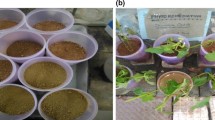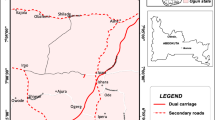Abstract
Crude oil exploration and production has been the largest anthropogenic factor contributing to the degradation of Momoge Wetland, China. To study the effects of crude oil on wetland soils, we examined the total petroleum hydrocarbon (TPH), total organic carbon (TOC), total nitrogen (TN), and total phosphorus (TP), as well as pH and electricity conductivity (EC) from oil sites and uncontaminated areas in the Momoge Wetland. All contaminated areas had significantly higher (p < 0.05) contents of TPH and TOC, but significantly lower (p < 0.05) TN contents than those of the uncontaminated areas. Contaminated sites also exhibited significantly higher (p < 0.05) pH values, C/N and C/P ratios. For TP contents and EC, no significant changes were detected. The level of soil contamination and impact of oil residuals on soil quality greatly depended on the length of time the oil well was in production. Oil residuals had caused some major changes in the soils’ chemical properties in the Momoge Wetland.
Similar content being viewed by others
References
Al-Darwish, H. A., Abd El-Gawad, E. A., Mohammed, F. H., & Lotfy, M. M. (2005). Assessment of contaminants in Dubai coastal region, United Arab Emirates. Environmental Geology, 49, 240–250. doi:10.1007/s00254-005-0078-z.
Andrade, M. L., Covelo, E. F., Vega, F. A., & Marcet, P. (2004). Effect of the Prestige oil spill on salt marsh soils on the coast of Galicia (northwestern Spain). Journal of Environmental Quality, 33, 2103–2110.
APHA (1992). Standard methods for the examination of water and wastewater (18th ed.). Washington, DC: American Public Health Association.
Atlas, R. M., & Bartha, R. (1973). Stimulated biodegradation of oil slicks using oleophilic fertilizers. Environmental Science & Technology, 7, 538–541. doi:10.1021/es60078a005.
Barakat, A. O., Qian, Y., Kim, M., & Kennicutt, M. C. (2001). Chemical characterization of naturally weathered oil residues in arid terrestrial environment in Al-Alamein, Egypt. Environment International, 27, 291–310. doi:10.1016/S0160-4120(01)00060-5.
Bollag, J. M. (1992). Decontaminating soil with enzymes. Environmental Science & Technology, 26, 1876–1881. doi:10.1021/es00034a002.
Braddock, J. F., Ruth, M. L., Catterall, P. H., Walworth, J. L., & McCarthy, K. A. (1997). Enhancement and inhibition of microbial activity in hydrocarbon-contaminated arctic soils: Implications for nutrient-amended bioremediation. Environmental Science & Technology, 31, 2078–2084. doi:10.1021/es960904d.
Bremner, J. M., & Mulvaney, C. S. (1982). Nitrogen—total. In A. L. Page, R. H. Miller, & D. R. Keeney (Eds.), Methods of soil analysis. Part 2 (2nd ed.). Agron. Monogr. (Vol. 9, pp. 595–624). Madison, WI: ASA and SSSA.
Burns, K. A., Garrity, S. D., & Levings, S. C. (1993). Review: How many years until mangrove ecosystems recover from catastrophic oil spills? Marine Pollution Bulletin, 26, 239–248. doi:10.1016/0025-326X(93)90062-O.
Carls, E. G., Fenn, D. B., & Chaffey, S. A. (1995). Soil contamination by oil and gas drilling and production operations in Padre Island National Seashore, Texas, USA. Journal of Environmental Management, 45, 273–286. doi:10.1006/jema.1995.0075.
Consulting, A. L. L. (2003). Handbook on coal bed methane produced water: Management and beneficial use alternatives. Prepared for: Groundwater Protection Research Foundation, US Department of Energy, National Petroleum Technology Office, Bureau of Land Management, July.
Corredor, J. E., Morrell, J. M., & Del Castillo, C. E. (1990). Persistence of spilled oil in a tropical intertidal environment. Marine Pollution Bulletin, 21, 385–388. doi:10.1016/0025-326X(90)90647-Q.
Cunningham, S. D., Anderson, T. A., Schwab, A. P., & Hsu, F. C. (1996). Phytoremediation of soils contaminated with organic pollutants. Advances in Agronomy, 56, 55–114. doi:10.1016/S0065-2113(08)60179-0.
DeLaune, R. D., Patrick, W. H. J., & Buresh, R. J. (1979). Effect of crude oil on a Louisiana Spartina Alterniflora Salt Marsh. Environmental Pollution, 20, 21–31. doi:10.1016/0013-9327(79)90050-8.
Ferrell, R. E., Seneca, E. D., & Linthurst, R. A. (1984). The effects of crude oil on the growth of Spartina alterniflora Loisel. and Spartina cynosuroides (L.) Roth. Journal of Experimental Marine Biology and Ecology, 83, 27–39. doi:10.1016/0022-0981(84)90115-1.
Hambrick, G. A., DeLaune, R. D., & Patrick, W. H. (1980). Effect of estuarine sediment pH and oxidation–reduction potential on microbial hydrocarbon degradation. Applied and Environmental Microbiology, 40, 365–369.
Jobson, A., McLaughlin, M., Cook, F. D., & Westlake, D. W. S. (1974). Effect of amendments on the microbial utilization of oil applied to soil. Applied Microbiology, 27, 166–171.
Karvelas, M., Katsoyiannis, A., & Samara, C. (2003). Occurrence and fate of heavy metals in the wastewater treatment process. Chemosphere, 53, 1201–1210. doi:10.1016/S0045-6535(03)00591-5.
Ko, J. Y., & Day, J. W. (2004). A review of ecologyical impacts of oil and gas development on coastal ecosystems in the Mississippi Delt. Ocean and Coastal Management, 47, 597–623. doi:10.1016/j.ocecoaman.2004.12.004.
Lin, Q., & Mendelssohn, I. A. (1996). A comparative investigation of the effects of south Louisiana crude oil on the vegetation of fresh, brackish and salt marshes. Marine Pollution Bulletin, 32, 202–209. doi:10.1016/0025-326X(95)00118-7.
Lin, Q., & Mendelssohn, I. A. (1998). The combined effects of phytoremediation and biostimulation in enhancing habitat restoration and oil degradation of petroleum contaminated wetlands. Ecological Engineering, 10, 263–274. doi:10.1016/S0925-8574(98)00015-9.
Mitsch, W. J., & Gosselink, J. G. (1993). Wetlands. New York: Van Nostrand Reinhold.
Nyman, J. A. (1999). Effect of crude oil and chemical additives on metabolic activity of mixed microbial populations in fresh marsh soils. Microbial Ecology, 37, 152–162. doi:10.1007/s002489900139.
Nyman, J. A., Klerks, P. L., & Bhattacharyya, S. (2007). Effects of chemical additives on hydrocarbon disappearance and biodegradation in freshwater marsh microcosms. Environmental Pollution, 149, 227–238. doi:10.1016/j.envpol.2006.12.028.
Oudet, J. (1989). Hydrocarbon weathering and biodegradation in a tropical estuarine ecosystem. Marine Environmental Research, 27, 195–213. doi:10.1016/0141-1136(89)90024-X.
Pan, X., Zhang, D., & Quan, L. (2006). Interactive factors leading to dying-off Carex tato in Momoge wetland polluted by crude oil, Western Jilin, China. Chemosphere, 65, 1772–1777. doi:10.1016/j.chemosphere.2006.04.063.
Pezeshki, S. R., Hester, M. W., Lin, Q., & Nyman, J. A. (2000). The effects of oil spill and clean-up on dominant US Gulf coast marsh macrophytes: A review. Environmental Pollution, 108, 129–139. doi:10.1016/S0269-7491(99)00244-4.
Samanta, S. K., Singh, O. V., & Jain, R. K. (2002). Polycyclic aromatic hydrocarbons: Environmental pollution and bioremediation. Trends in Biotechnology, 20, 243–248. doi:10.1016/S0167-7799(02)01943-1.
Sandvik, S., Lode, A., & Pederson, T. A. (1986). Biodegradation of oily sludge in Norwegian soils. Applied Microbiology and Biotechnology, 23, 297–301. doi:10.1007/BF00261932.
Schreier, C. G., Walker, W. J., Burns, J., & Wilkenfeld, R. (1999). Total organic carbon as a screening method for petroleum hydrocarbons. Chemosphere, 39, 503–510. doi:10.1016/S0045-6535(98)00598-0.
SPSS (2005). SPSS 14.0 for Windows. Chicago, IL: SPSS Inc.
Teal, J. M., Farrington, J. W., Burns, K. A., Stegeman, J. J., Tripp, B. W., Woodin, B., et al. (1992). The West Falmouth oil spill after 20 years: Fate of fuel oil compounds and effects on animals. Marine Pollution Bulletin, 24, 607–614. doi:10.1016/0025-326X(92)90281-A.
Author information
Authors and Affiliations
Corresponding author
Rights and permissions
About this article
Cite this article
Wang, X., Feng, J. & Zhao, J. Effects of crude oil residuals on soil chemical properties in oil sites, Momoge Wetland, China. Environ Monit Assess 161, 271–280 (2010). https://doi.org/10.1007/s10661-008-0744-1
Received:
Accepted:
Published:
Issue Date:
DOI: https://doi.org/10.1007/s10661-008-0744-1




